ARCHITECTURAL REVIEW
23 April, 2013
George Simaioforides 2002-2012
10 Years since the death of George Simaioforides.

«The question is whether there are possibilities, whereby increasing information does not result in the loss of aesthetic and the reality of experience"
George Simaioforides " DIELEFSEIS"
"Dionysus returns to the city", 1986.
OMONOIA SQUARE
In memory of George Simaioforides
February 2012
I am standing, holding a hot coffee, on the ground floor of the architect Ziller building, right in the corner of Athena Str. and the Omonoia square, right next to the "Everest" tables. The floors are empty in the "Baggeio Hotel". I am admiring the view of Omonoia square. I stand inside the thick walls of the four storey neoclassical building, observing from the inside, the arched openings, visible from the small diagonal loft. I can also see the arches of a similar architect Ziller building, right across the street where the hotel "Alexander the Great" is located (1). The thin metal shutters, under the arches and between the thick walls, are now lifted and let the cold air and snowflakes flowing through the building.
I remember like it was yesterday the development of the Omonoia Tube Station and George, who next year, as a member of the Sadas-Pea Council, had recommended architect Yiannis Zervos as a representative, who is a cognizant of the principles for Preservation and Conservation and a student of Roberto Di Stefano in the Council of Modern monuments, Ministry of Culture. (5)
He persistently interfered during the reconstruction of the line -1 of ISAP from Attico-Metro construction (6). The Ministry of Culture announced some important decisions concerning the maintenance of the old Tube Station of Omonoia and Victoria Square, which were constructed in 1928-1930, at a first level: the geometry of the space must not be altered, the old beautiful orange and purple decorative tiles must not be removed from the walls, the stairs and the wrought iron railings must not be replaced with new ones, standardized, an imitation of the metro works. They complained about the historical significance of all train stations from Peraias to Omonoia,- the second core of the historic triangle in the centre of Athens- and have requested their preservation from Victoria to Attica. In the end, by Ministry of Culture's decision, they managed to rescue the features in the stations of Omonoia and Victoria.
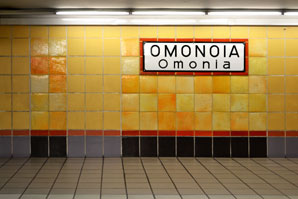
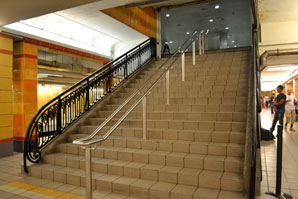
The inside of old line-1, after the reconstruction
George came to our office in September 1998 with G. Aisopos and told us: "I know you work in modernism, I happen to have an exhibition in Rotterdam for the Greek Architecture of the 60's -90's, at the offices of the Netherlands Institute of Architects. Would you like to participate?" (7) and so we met. We accepted and I found myself, in February 1999, among the team of Greek architects that he himself guided through the contemporary architecture of Koolhaas, Bakema, Mecanoo, in Hague, Delft, Rotterdam...
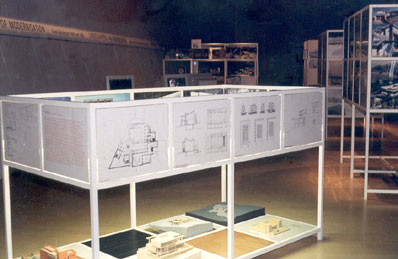
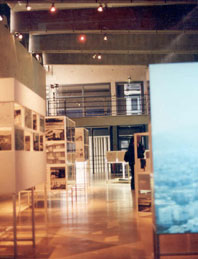
From the exhibition of Greek Architecture in NAI, ROTTERDAM
George always comes to my mind.
When I opened the practices of "The Charter of Athens" of IV CIAM Athens 1933- once more to see the conclusions of the conference about the "Historical Heritage of the Cities", something related to the problems caused in architectural composition in Greece due to the morphological restrictions set by the Ministry of Environment with mr. Sifounakis and some professors of NTUA who support him, how to build our constructions in future as an imitation of the forms of the past, in report no 70 I read: "Copying the past as slaves, means that we are condemned to lies, that we proclaim fake as a guiding principle"!...(8)
I found there the introduction of George Simaioforides. I read important texts from his conversations with architects Georges Kandillis and Aristomenis Proveleggios in May 1987. I recalled our common love for Aristomenes and the countless hours we spent in his office, with George Simaioforides first and with me later, for different reason every one of us.
I write once more that George is one of the few theorist architects of my generation who engaged in the public life of our country, faithful to the European critical thinking, in the principals of the Charter of Venetia and the Granada Convention.
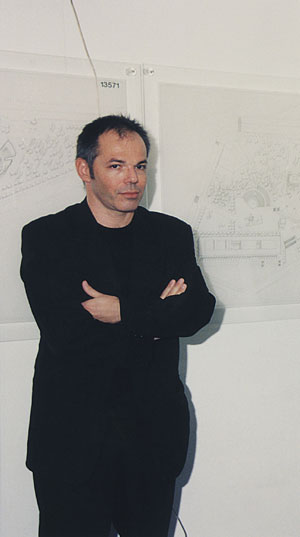
Epilogue
Omonoia has lost its orientation.
Omonoia Square has turned into a "Circulation Space" of vehicles and pedestrians, a place for immigrants, those who in any case are wasting their time admiring Acropolis from some long linear bleachers 50 meters. That means for nobody healthy citizen. The only thing I don't see, walking from Agiou Konstantinou str. towards Panepistimiou str, is Acropolis. I feel as an immigrant among immigrants and they look at me with curiosity and pity. Not even are built the glass blocks on the surface square looking down to the pedestrians, proposed by the architects of the awarding design in the Architectural Competition for the Redevelopment of Athens.
The large irrelevant "sculpture" behind the long linear bleachers block the visual communication between the square and the old mansions, on the sides of 3rd Septemvriou str, Dorou str. and Panepistimiou str. The old coffee- shop "NEON" of the old mansion is well-preserved, but closed... I count almost four building blocks among eight, which are occupied by three-storey or four- storey buildings, mansions or neoclassical buildings. The "sculpture" behind the long linear bleachers in the overlooking of Acropolis are overly elevated, obstructing the visual communication between Omonoia Square and the surrounding buildings... In the end, since the square was constructed with a relative paraphrasing of the First Prize of the Architectural Competition (9), the citizens are deprived of the opportunity to have a critical dialogue with architecture... as George would have asked for...
But he himself had clearly defined his criticism, years ago about new proposals for the Squares in the city of Athens, during his speech at the 10th conference of 1999:
" In the joint presentation of the architectural studies, is revealed the peculiarities and weaknesses of public urban spaces in Greece: Obsessions on latent geometrical engravings, the overuse of materials and design solutions... The specific competitions were somewhere disappointing. They could indeed become islets of design ventures, with an aim in finding a new sensitivity in designing open spaces. Instead the restrictions, especially the inability to relate design with the on-going traffic works (new metro lines) yielded the role of proposals that merely "upgrade" the worn-out face of the city..."
"New urban landscape-design-New behaviors"
10 th Architectural Congress SADAS -PEA
George Simaioforidis "DIELEFSEIS"
You left ingloriously George!
Not even Omonoia Square reminds me of you!
Goodbye my friend...
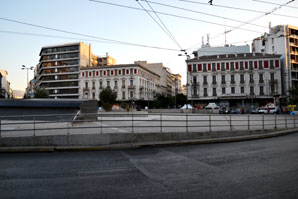
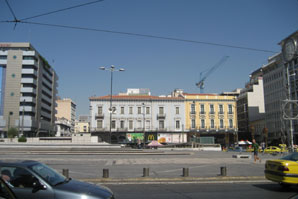
(Right) Omonoia Square with thw two neoclassical Hotels of architect ZILLER, (Left) View of part of Omonoia Square from Athena str
by Anastasia Pepe, architect
References - Bibliography
(1)By order of the Pagkeios Commission, architect E. Ziller constructed the first Hotel "Bagkeio Hotel" (1889-1894) and the Hotel "Alexander the Great", next to the first one; two of the most formal hotels at the time. "The hotels of Athena Str." Eleni Papandreou Vlahou, KATHIMERINI, Epta Imeres, 17.2.2000.
(2) Works of the subversive theatrical writer Dario Fo, connecting the randomness of death of an important individual with social terrorism. "This case demonstrates Calatrava's undemocratic process of building the city" writes George Simaioforidis on 12 November 2001, in the last published article on "architecture and Urban Democracy", TEE no 2174, three months before his death. Architect S. Calatrava had already arrived in Athens, along with the exhibition of his work at the National Gallery in April 2001, to undertake public works for the Olympic Games in 2004.
(3) 10 th Hellenic Architectural Congress SADAS -PEA from the 8th to 12th Dec. 1999 on "Architecture and the Greek city in the 21st century". The tedious task of issuing the practical's on behalf the Comity, was done in the end by N. Siapkidis.
(4) "EUROPAN is an association which organizes architectural competitions for residential developments. The competitions exclusively refer to young architects under 40 years old and take place in several European countries. This innovative idea demanded the establishment of a large network of organizations and institutions. This was achieved in May 1988 in Madrid, when a group of professionals from 9 countries (Austria, Belgium, France, Germany, Switzerland, Greece, Spain, Italy and Holland) established a European federation of architectural competitions. In 1999 - EUROPAN-6 "In Between Cities, Architectural Dynamics and New Urbanity". "Dielefseis" George Simaioforides, Texts on architecture and metapolis, Metapolis Press 2005. The texts were collected and edited by G. Aesopos, G. Tzirtzilakis and Olga Simaioforides in the book "DIELEFSEIS" .
(5) No.28231/ 13.12.2001 SADAS- PEA to the Comity of modern monuments & ELEFTHEROTIPIA 6.12.2001 on «Lifting with new rules, after the important decision of "Omonoia station is a historical monument". By Hara Tzanavara.
(6) The old Line -1 : Omonoia, after the intervention of the Ministry of Culture, during its reconstruction in 2001, opened in 2004.
(7) "Landscapes of Modernization- Greek Architecture 1960s and 1990s" Nederlands Architectuurinstituut- NAi, February1999, Rotterdam. Curators: G. Aesopos and G. Simaioforides.
The catalogue of the exhibition with all the texts was published in English by Metapolis Press, while the Greek texts of the architects who participated in the exhibition, were published in 2002 as "Estimates" by the Centre of Mediterranean Architecture- KAM and Metapolis Press, with the relevant exhibition in Chania, Greece.
(8)The first edition of the 4th CIAM was held in France 1943 during the German Occupation. The processing and formulation of the conclusions was done by LECORBUSIER in 1941. The text was finalized when published in 1957.
(9)"Architectural Competition of four squares in Athens: Omonoia, Syntagma, Monastiraki, Koumoundourou square", EAXA corporation-2001.
«Reforming Omonoia square with suggestions regarding the surrounding buildings» First Price, architects A. Vozanis, G. Desillas, M. Katsika, Th. Tiatas.
List of figures
The two photographs of G. Gimaioforides are a courtesy of Olga Simaioforides - Emmanouilides.
Images form the exhibition in "NAI" are from the private archives of architect Anastasia Pepe, as well as the image-2 of the entrance of the old station Omonoia, showing the preservation of the old columns (1930) and the image -9.
Image -8 of Omonoia square and the two images showing the interior space of the old train station, are taken by photographer Penny Bouli.
Related articles:
- Industrial landscape in Aliveri ( 16 August, 2013 )
- Τhe cotton gin of lower. Tithorea at grandpa s old factory ( 22 July, 2013 )
- Crete-from the northern winds of the sea of Crete to the flame of the Libyan land ( 27 October, 2013 )
- Edipsos ( 22 March, 2014 )
- Wooden single house in Dioni, Attica ( 13 March, 2014 )
- Kerameikos of Athens ( 16 October, 2014 )










